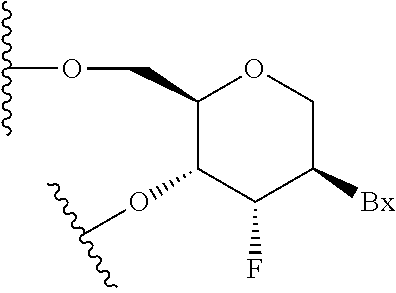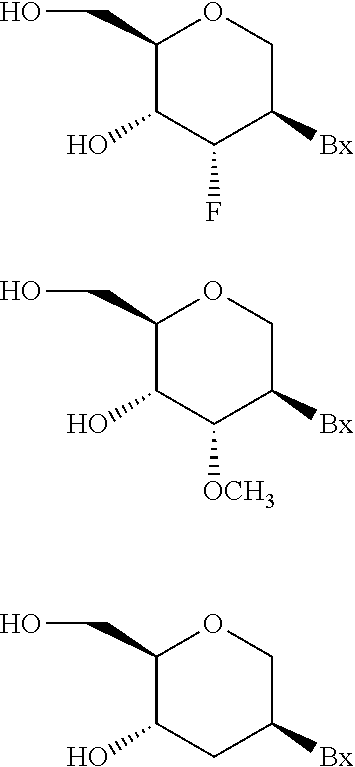Modulation of cd40 expression
a technology of cd40 and expression, applied in the field of cd40 expression modulation, can solve the problems of no known therapeutic agent which effectively inhibits the synthesis of cd40, and studies are terminated
- Summary
- Abstract
- Description
- Claims
- Application Information
AI Technical Summary
Benefits of technology
Problems solved by technology
Method used
Image
Examples
example 1
Antisense Inhibition of Human CD40 In Vitro
[0321]Antisense oligonucleotides targeted to a CD40 nucleic acid were tested for their effects on CD40 mRNA in vitro. When cultured cells, grown in a 96-well plate, reached 80% confluency, they were treated with 150 nM antisense oligonucleotide. After a treatment period of approximately 24 hours, RNA was isolated from the cells and CD40 mRNA levels were measured by quantitative real-time PCR, as described herein. CD40 mRNA levels were adjusted according to total RNA content as measured by normalization to RIBOGREEN®. Results are presented as percent inhibition of CD40, relative to untreated control cells in Table 1.
[0322]The antisense oligonucleotides were designed as 18-mers with phosphorothioate backbones (internucleoside linkages) throughout. “5′ target site” indicates the 5′-most nucleotide which the antisense oligonucleotide is targeted to SEQ ID NO: 1 (GENBANK® Accession No X60592.1). Data are averages from three experiments.
TABLE 1In...
example 2
Antisense Inhibition of Human CD40 In Vitro
[0323]Antisense oligonucleotides targeted to a CD40 nucleic acid were tested for their effects on CD40 mRNA in vitro. T24 cells at a density of 7000 cells per well in a 96-well plate were treated with 150 nM antisense oligonucleotide. After a treatment period of approximately 24 hours, RNA was isolated from the cells and CD40 mRNA levels were measured by quantitative real-time PCR, as described herein. CD40 mRNA levels were adjusted according to GAPDH content, a housekeeping gene. Results are presented as percent inhibition of CD40, relative to untreated control cells in Table 2.
[0324]The antisense oligonucleotides were designed as 4-10-4 gapmers, where the gap segment comprises 2′-deoxynucleotides and each wing segment comprises 2′-MOE nucleotides and 5-methylcytosine substitutions. The antisense oligonucleotides comprise phosphorothioate backbones (internucleoside linkages) throughout. “5′ target site” indicates the 5′-most nucleotide whi...
example 3
Antisense Inhibition of Human CD40
[0325]Antisense oligonucleotides targeted to a CD40 nucleic acid were tested for their effects on CD40 mRNA in vitro. T24 cells at a density of 7000 cells per well in a 96-well plate were treated with 100 nM of antisense oligonucleotide. After a treatment period of approximately 24 hours, RNA was isolated from the cells and CD40 mRNA levels were measured by quantitative real-time PCR, as described herein. CD40 mRNA levels were adjusted according to GAPDH content, a housekeeping gene. Results are presented as percent inhibition of CD40, relative to untreated control cells in Table 3.
[0326]The antisense oligonucleotides were designed as 4-10-4 gapmers, where the gap segment comprises 2′-deoxynucleotides and each wing segment comprises 2′-MOE nucleotides. The antisense oligonucleotides comprise phosphorothioate backbones (internucleoside linkages) and 5-methylcytosine substitutions throughout. “5′ target site” indicates the 5′-most nucleotide which the...
PUM
| Property | Measurement | Unit |
|---|---|---|
| diameter | aaaaa | aaaaa |
| pH | aaaaa | aaaaa |
| pH | aaaaa | aaaaa |
Abstract
Description
Claims
Application Information
 Login to View More
Login to View More - R&D
- Intellectual Property
- Life Sciences
- Materials
- Tech Scout
- Unparalleled Data Quality
- Higher Quality Content
- 60% Fewer Hallucinations
Browse by: Latest US Patents, China's latest patents, Technical Efficacy Thesaurus, Application Domain, Technology Topic, Popular Technical Reports.
© 2025 PatSnap. All rights reserved.Legal|Privacy policy|Modern Slavery Act Transparency Statement|Sitemap|About US| Contact US: help@patsnap.com


